
by Chris Monahan
It's a familiar scenario
- you're cruising around looking for a little friendly competition.
You come across a worthy challenger and an open stretch
of road. It's 'on'. The rpms rise as your eyes toggle between
the road ahead and the car beside you. The motor is pulling
hard and you seem to be gaining ground. Then without warning
the car noses over and the dreaded sound of full tilt rev
limiter fills the air. Your competition is now a pair of
tail lights in the distance.
If you are manually changing your gears, be it with an automatic
or a stick transmission, it is up to you to shift at the
right rpm for optimum performance. Shifting too early hinders
engine performance as does shifting too late. Shifting too
late however can also result in engine damage, especially
if you are not equipped with a rev limiter. If you are a
bracket racer shifting each gear and each pass inconsistently
results in unpredictable ET's and an eventual early exit.
The solution is not to watch the tachometer. In the heat
of battle things are happening too fast for the human brain
to process numerical data, along with observing the road
and competition. You've got to have a clear and accurate
signal that your brain can react to immediately. This is
no better achieved that an optical signal, such as a bright
shift light.
Shift lights have been around for a while, but their size
and overall gaudiness made them plain goofy for street cars.
The older generation lights were based on standard light
bulbs, which weren't exceptionally bright and thus hard
to see in sunlight. Furthermore with the complexities of
late-model, distributorless ignition systems, installing
a shift light generally also required some sort of electronic
module to create an rpm input signal. Well forget about
all that. The new generation of LED shift lights utilize
modern technology to not only eliminate the wiring headaches,
but to slim down the package into a trim little tube about
the diameter of a nickel. The Raptor Performance shift light
was one we learned about recently and became so impressed
by the technology that we installed them in our early and
late model project cars. They literally take a few minutes
to hook up, and your only challenge may be deciding where
to put it. We've shown you a couple cool placements below.
It will likely help you win the next grudge match, and definitely
provide a little extra insurance in case your eyes are justifiably
not glued to the rpm needle.
| Installation |
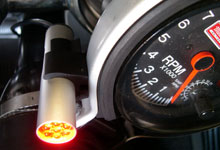
 A traditional option is to mount on the side of an aftermarket
tachometer. Tap the green wire into to the tach's rpm
lead, or directly to the MSD tach output terminal, or
negative side of the coil on stock ignitions.
A traditional option is to mount on the side of an aftermarket
tachometer. Tap the green wire into to the tach's rpm
lead, or directly to the MSD tach output terminal, or
negative side of the coil on stock ignitions. |

 On our '04 Cobra we placed the shift light right between
the tach and boost gauge, using the existing bezel screw
to mount the included bracket. Run the wire in through
the small gap between the bezel and lens.
On our '04 Cobra we placed the shift light right between
the tach and boost gauge, using the existing bezel screw
to mount the included bracket. Run the wire in through
the small gap between the bezel and lens. |

 Our favorite mounting location is in the center vent,
as seen here on a '99-04 Mustang. This keeps it out
the way and stealthy. The LED's are plenty bright to
see during the day time.
Our favorite mounting location is in the center vent,
as seen here on a '99-04 Mustang. This keeps it out
the way and stealthy. The LED's are plenty bright to
see during the day time. |

 To mount in the vent remove both the driver side center
vent, and the passenger side vent near the glove box.
To mount in the vent remove both the driver side center
vent, and the passenger side vent near the glove box.
|

 With the vents removed, drill or punch a 1/4" hole
in the plastic air duct, towards the glove box end.
With the vents removed, drill or punch a 1/4" hole
in the plastic air duct, towards the glove box end. |

 To pass the shift light's wire through the vent, we
bent a coat hanger and fed it through the passenger
vent and out the center drivers vent. Hook the wire
up and pull it back through.
To pass the shift light's wire through the vent, we
bent a coat hanger and fed it through the passenger
vent and out the center drivers vent. Hook the wire
up and pull it back through. |
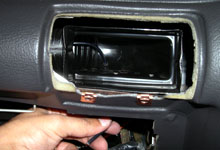
 Push the end of the wire harness through the hole created
in the duct. Pull the wire down behind the glove box.
Push the end of the wire harness through the hole created
in the duct. Pull the wire down behind the glove box. |
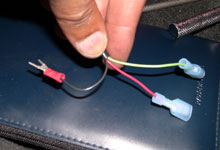
 Strip back the outer sheath to expose the three leads.
The shift light comes with splice terminals, however
we opted for a more secure type of terminal. Install
crimp-on terminal as shown.
Strip back the outer sheath to expose the three leads.
The shift light comes with splice terminals, however
we opted for a more secure type of terminal. Install
crimp-on terminal as shown. |

 Remove the passenger side kick panel to gain access
to the PCM and main computer harness.
Remove the passenger side kick panel to gain access
to the PCM and main computer harness. |

 On '99-'04 Mustangs the red wire in the grey connector
(arrow) is 12V key-on. We'll splice the Raptor's 12V
red lead into this wire.
On '99-'04 Mustangs the red wire in the grey connector
(arrow) is 12V key-on. We'll splice the Raptor's 12V
red lead into this wire. |
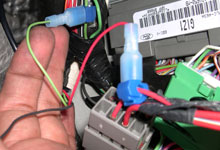
 Due to the coil-on-plug ignitions on '99-'04 Mustangs
we can tap into any of the 8 individual cylinder coil
wires at the PCM.
Due to the coil-on-plug ignitions on '99-'04 Mustangs
we can tap into any of the 8 individual cylinder coil
wires at the PCM.
|

 Attach the ground wire to a good chassis ground, we
used this factory ground point below the PCM harness.
Attach the ground wire to a good chassis ground, we
used this factory ground point below the PCM harness. |

 On '99-'04 Mustangs set the dip switches to 1-cylinder
mode, as indicated in the instructions. The desired
light-on rpm is set by the dials - the left one for
1000 rpm increments, and the second for x 100 rpms.
On '99-'04 Mustangs set the dip switches to 1-cylinder
mode, as indicated in the instructions. The desired
light-on rpm is set by the dials - the left one for
1000 rpm increments, and the second for x 100 rpms. |
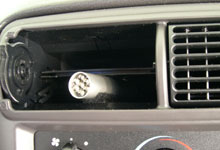
 We used stick-on Velcro tabs to mount the shift light
in the vent. Set it just far back enough to allow the
vent grill to fit into place.
We used stick-on Velcro tabs to mount the shift light
in the vent. Set it just far back enough to allow the
vent grill to fit into place.  |
|
|
|
| |
|
| |
|
In
This Article:
A review and installation of a super-tiny and simple
LED shift light by Raptor Performance. |
|
|

Unlike conventional shift lights, the Raptor light is conveniently
small and light weight. All electronics are self contained,
meaning no separate "pills" or rpm converters
are needed to make it work.
|
|
How LED's Work
 Unlike
a conventional light bulb, an LED (Light Emitting Diode)
works on the principals of semiconductors. The movement
of electrons in the diode gives off photons, the basic
unit of light. In an LED, these photons are projected
towards the tip of the bulb, producing an intense visible
light. An LED bulb has no filament or inert gas in it,
and thus cannot burn out. Furthermore an LED bulb is
plastic and more durable. Finally, LED's are more efficient.
Only about 10% of the energy from a conventional light
bulb is in the form of visible light, the rest is infrared
or heat. Unlike
a conventional light bulb, an LED (Light Emitting Diode)
works on the principals of semiconductors. The movement
of electrons in the diode gives off photons, the basic
unit of light. In an LED, these photons are projected
towards the tip of the bulb, producing an intense visible
light. An LED bulb has no filament or inert gas in it,
and thus cannot burn out. Furthermore an LED bulb is
plastic and more durable. Finally, LED's are more efficient.
Only about 10% of the energy from a conventional light
bulb is in the form of visible light, the rest is infrared
or heat. |
|
|
| |
| |
Contacts:
Raptor Performance
349-L Copperfield Blvd # 226
Concord, NC 28025
Tel: 704-796-8409
http://www.raptorperformance.com/
|
|

